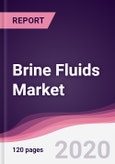Brine Fluids are high concentrated solution contains high salts and used for wide applications like food processing, De-icing and preparation of chemical compounds. The global Brine fluid market is estimated to generate a revenue of $2,159.81 million in 2017 and is projected to reach $2,843.41 by 2023 at a CAGR of 5.65 %. U.S country, especially North American regions are the largest markets for Brine Fluids market. Next to U.S, APAC countries are having increased demand on Brine fluids because china is dealing with shale gas exploration. Also growing oil exploration activities in India will increase the growth of Brine Fluids market during the forecast period.
Brine Fluids Market Outlook:
Brine fluids can be prepared with single salts or combination of two or more salts. The density of Brine fluids depends upon types of salts used. The blends of brine fluids are made up of Sodium chloride, potassium chloride, calcium chloride, of Sodium bromide, potassium bromide and calcium bromide and so on. These brine solutions are used for processing food and cooking, Refrigeration fluid, Anti –icing for roads, drilling purpose. The end use industries include Water softening industries, Oil and Gas, Medical, chemical, Pharmaceutical, Food and beverages, Semiconductors and so on. The brine based fluids has become most utilized systems for drilling purpose. Growing exploration activities in oil and gas segments in different regions boost the market of brine fluids. Also calcium chloride type of brine fluid accounted largest share with 23% across globe and grows at a CAGR of 7.69% during the forecast period 2018-2023.
The pricing analysis of brine fluids like sodium chloride has lowest price compared to other products. Market price of Sodium chloride is $ 3.6 per ton in 2017 and forecast to reach $3.5 per ton. Calcium Bromide has $15 per ton and forecast to reach $15.2 per ton.
Brine Fluids Market Growth Drivers:
Increased Drilling activities across globe has increases the demand of Brine based fluids that became driving force in the market. The brine based products like bromides and chlorides are used in wide applications are expected to drive the global market. Also the low cost factor and corrosive resistance properties of brine fluids drives the market growth.
Brine Fluids Market challenges:
The fluctuations in raw material prices for production of brine fluid compounds became challenge in the market. But fluctuation doesn’t effect the demand for brine fluids because the low cost sodium chloride and potassium chlorides occupy largest share among other brine fluid blends. Also water based muds are less expensive compared to brine fluids. But effective drilling properties of brine fluids has high growth in the market.
Brine Fluids
Brine Fluids Market Research Scope:
The base year of the study is 2017, with forecast done up to 2023. The study presents a thorough analysis of the competitive landscape, taking into account the market shares of the leading companies. It also provides information on unit shipments. These provide the key market participants with the necessary business intelligence and help them understand the future of the Brine Fluids Market. The assessment includes the forecast, an overview of the competitive structure, the market shares of the competitors, as well as the market trends, market demands, market drivers, market challenges, and product analysis. The market drivers and restraints have been assessed to fathom their impact over the forecast period. This report further identifies the key opportunities for growth while also detailing the key challenges and possible threats. The key areas of focus include the types of Brine Fluids Market, and their specific applications in different types of vehicles.
Brine Fluids Market Report: Industry Coverage:
Sources of Brine Fluids Market: Salt lakes, Brine pools, Earth’s Crust, Industrial desalination Effluents, Others
Product Types of Brine Fluids Market: Potassium Chloride, Sodium Chloride, Calcium Chloride, Potassium Bromide, Sodium Bromide, Calcium Bromide, Others
Applications of Brine Fluids Market: Food processing and cooking, De-Icing, Chlorine Production, Others
End User Industries of Brine Fluids Market: Water softening Industries, Medical, Oil and Gas, Agricultural, Chemicals, Petrochemicals, Food and Beverages, Semi -conductors, Others.
Brine Fluids Market report also analyzes the major geographic regions for the market as well as the major countries for the market in these regions. The regions and countries covered in the study include:
- North America: The U.S., Canada, Mexico
- South America: Brazil, Venezuela, Argentina, Ecuador, Peru, Colombia, Costa Rica
- Europe: The U.K., Germany, Italy, France, The Netherlands, Belgium, Spain, Denmark
- APAC: China, Japan, Australia, South Korea, India, Taiwan, Malaysia, Hong Kong
- Middle East and Africa: Israel, South Africa, Saudi Arabia
Brine Fluids Market Key Player Perspective:
The key players referred in this market are Albemarle Corporation, Bakers Hughes Inc, Chemtura corporation, Clements Fluids, Geo Drilling Fluids Inc, Great Lake solutions, Halliburton, Israel Chemicals Ltd, Egyptian Mud Engineering & chemicals Company and 10 more companies.
Brine Fluids Market Trends and Market Research:
Tetra Technologies which is leading company of oil and gas and other fluid associated products has acquired Swift Water Energy services. This acquired company became part of tetra’s fluid business division.
The increased demand for preservative and canned food using brine fluids has increased the market in developing countries. Also the oil exploring methods has robust growth in the market.
In 2014, Tetra Chemicals made an agreement with Tessenderlo Group regarding the production and marketing of calcium chloride product. This agreement will make both companies as global leaders in the market of calcium chloride.
Table of Contents
Methodology

LOADING...








